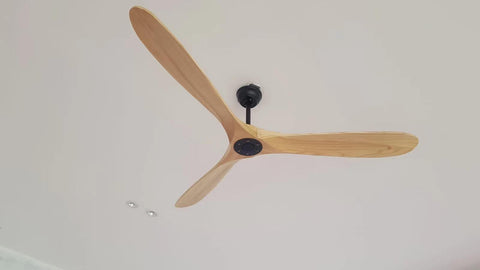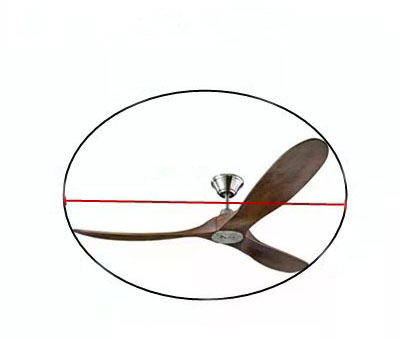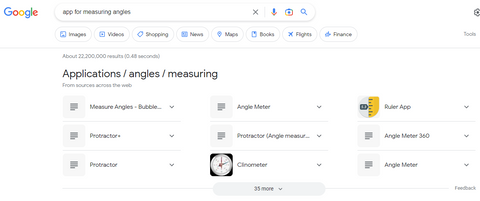
Ceiling fans are among the most beneficial fixtures that can elevate the aesthetics of any room in your house. Not only do they offer decorative charm, but they also serve a functional purpose throughout the year. Some ceiling fans are equipped with lighting and have the capability to move air in an upward or downward direction, creating a warm atmosphere during the winter months and a cool one during the summer months. In addition, they consume less energy than an air conditioning system.
The best ceiling fans come with a variety of options, such as the ability to be mounted in the most appropriate location, at the ideal height, and ceiling fans blades that are large enough to move the most air. Our top selections also provide lighting where needed, can be controlled with ease via remote, and some models are even suitable for installation in damp outdoor areas.
When seeking to replace an outdated ceiling fan or purchase best ceiling fan for bedrooms or anywhere else , it's crucial to determine the correct size of ceiling fans for optimal performance and effectiveness. To help you select the appropriate size for your new ceiling fans, consider the following tips:
1. Measure the Room: Step one in determining the size of ceiling fan required for your space is to accurately measure the room itself. This can be accomplished by measuring both the length and width of the room, and then multiplying the two measurements to obtain the total square footage.

2. Calculate the Fan Size: Step two involves calculating the best fan size for your room, based on the square footage. The size of fan required will depend on the room’s dimensions, with smaller fans being suitable for more compact areas such as guest bedrooms or bathrooms. In contrast, larger fans are recommended for more larger spaces like living areas or master bedrooms. For especially large rooms, consider utilizing multiple fans.
For rooms that measure 75 square feet or less, a fan with a blade span of 29-36 inches is recommended. Rooms ranging from 76 to 144 square feet will benefit from a fan with a blade span of 36-42 inches, while those between 145 and 225 square feet require a fan with a blade span of 44 inches. For rooms measuring 226 to 400 square feet, a fan with a blade span of 5--54 inches is appropriate. For spaces larger than 400 square feet, the use of multiple fans may be necessary.
May you can’t miss this issue.
What is the Blade Span?
The blade span is simply the distance from the tip of one fan blade to the tip of the blade directly opposite it when the fan is in motion, which gives you the diameter of the circle that the blades move in.

3. Consider the Ceiling Height: Step three is to take the height of the ceiling into account when choosing the appropriate fan size. It’s important to measure the distance from the floor to the ceiling to ascertain the ideal mount type (such as flush, downrod, or standard) for the location where the fan will be installed.

Mounting a ceiling fan too close to the ceiling can result in less air circulation around the room. It’s best to hang the fan in the middle of the room and allow at least 18 inches of space from the walls.
For rooms with ceilings that are 8 feet or lower, it is recommended to use a low-profile fan with flush mount type. On the other hand, for rooms with ceilings higher than 8 feet, a downrod is necessary to lower the fan to an appropriate height. This is particularly important in spaces such as living rooms, where the fan needs to be positioned at a comfortable height for optimal functionality.
By following the above steps to find the best fan for you. You may also want to consider other important issues next.
How to choose the size of downrod for my ceiling fans?
Vaulted ceilings may require longer downrods to avoid collision with sloping roofs or walls. For rooms with low ceilings, a flush mount is ideal. To determine the correct downrod length, measure the height of your ceiling. Subtract 4 inches from the downrod length if your ceiling fan includes a light kit. If you have a tall, vaulted or sloped ceiling, it’s recommended to hang your ceiling fan from a downrod to lower it to the desired height of 8 or 9 feet from the floor. However, for sloped ceilings, it’s important to check that the ceiling fan you plan to purchase can be installed at an angle. If not, a sloped-ceiling mounting kit may be required.
How to choose ceiling fans for my sloped-ceilings or vaulted ceilings?

1. Calculate the Degree of Slope: For the first step, you might need to calculate the degrees of slope on your ceiling with an app. To find an app for measuring angles, simply search for “angle measuring app”on Google. There are several options available for you to download and use.

2. Contact Us: Once you have determined the slope angle of your ceiling, you can search for compatible ceiling fans or contact us at our website.
3. Choose the Appropriate Downrod Size: For installations on sloped ceilings, you may require a longer downrod. Normally, 5 inches and 10 inches downrods are included. However, for sloped ceilings, you may need to purchase an additional downrod to avoid collision with ceilings or walls.
The following table offers a useful summary of the downrod sizes required for vaulted ceilings or sloped ceilings with various angles. If your ceiling’s slope angle is not listed here, please contact us for further assistance.
| Angle | Downrod Length |
| 14° - 18° | 12" |
| 22° - 26° | 18" |
|
30° - 33°
|
24"
|
|
37° - 45°
|
36"
|
4. Find the perfect spot to install. It’s crucial to ensure maximum air flow, comfort and a balanced look. Regardless of the slope angle of your ceiling, ensure that the blade is at least 18 inches away from the closest wall. Additionally, the ceiling fan should be installed at a height of at least 8 feet above the floor.
How to choose ceiling fans for my damp rated outdoors?
Outdoor ceiling fans are specifically designed to be durable and withstand the different environments of outdoor spaces like patios or garages. Our ceiling fans come with features such as all-weather fan blades made of sturdy materials and waterproof, sealed motor casings. Even wooden blades are treated and tested multiple times to prevent moisture damage.
You can install outdoor ceiling fans in sheltered outdoor areas to help circulate air when there is not enough wind to keep things comfortable, such as on a porch or in a greenhouse. They can also be useful near outdoor fireplaces in winter to help move heated air and disperse smoke and fumes. Plus, they add a personalized indoor look and style to any outdoor space.
With summer here, it’s a great time to install an outdoor ceiling fan on your porch, or on a pergola to enhance your entire outdoor experience. Outdoor ceiling fans can help you stay cool during activities like playing or chatting with your children, making it easier to entertain, relax, and enjoy your time outside.
For areas that are covered but not directly exposed to rain, snow, water, or moisture, damp rated ceiling fans are ideal. These fans can be used in covered patios, porches, and other areas, as well as in damp rated indoor spaces like bathrooms or laundry rooms.
How to choose an energy efficient ceiling fan?
Choosing an energy-efficient ceiling fan can help you save money on your energy bills while keeping you cool and comfortable. Here are some tips to help you choose an energy-efficient ceiling fan:
- Look for a fan with a high airflow or CFM (Cubic Feet per Minute) rating. The higher the number, the more air the fan can move.
- When shopping for an energy-efficient ceiling fan, it is recommended to look for the ENERGY STAR label. This label indicates that the fan meets specific energy efficiency standards that are set by the U.S. Environmental Protection Agency.

- Opt for a fan with a DC motor instead of an AC motor. DC motors are more energy-efficient and will save you money in the long run.
- Look for a fan with multiple speed settings so you can adjust the airflow to your comfort level.
- Consider the size of the fan in relation to the room it will be used in. A fan that’s too small won’t provide adequate airflow, while a fan that’s too large will use more energy than necessary.
By following these tips, you can be assured that you are purchasing a product that will help you save money on your energy bills while reducing your carbon footprint.
Which is better for my room, ceiling fan with or without lights?
When it comes to deciding between a ceiling fan with or without a light, there are a few aspects that you should consider. You need to decide exactly where the ceiling fan needs to be located in your home and what you ideally want to use that space for. If your ceiling fan is going to be centered in the middle of a smaller room, like a bedroom, then you might find a ceiling fan with a light favorable. But, when the space where your ceiling fan will be is quite large, like a large kitchen or living room, it will be useful to steer towards a ceiling fan without lights, especially when the ceiling fan will not be centered.
If you are looking to conserve energy and reduce your electricity bills, it might be more efficient to choose a fan without lights. Fans with lights tend to consume more energy due to the additional lighting, which can add up to the overall power consumption of the fan. However, if you need additional lighting in your room, then choosing a fan with lights might be the better option for you. It ultimately depends on your personal preferences and needs.
By following these steps, you can ensure that you purchase a ceiling fan that is ideal for your room.
How to maintain my ceiling fans?
This is the last thing you need to think about when you buy a fan, and it's also an important aspect of ensuring that the fan you buy will last. Because proper maintenance of your ceiling fans can help ensure they operate efficiently and last for a long time. Here are some steps you can take to maintain your ceiling fans:
Tips: Make sure your fan is turned off before attempting any maintenance.
Please let me know if you would like to hear the remaining steps.
- Clean the blades: Cleaning the blades is an essential step in maintaining your ceiling fan, as dust and dirt buildup can cause it to wobble and operate inefficiently. To clean the blades, first turn off the fan and use a damp cloth to wipe down each blade. For a more thorough cleaning, you can use a soapy water solution or a pillowcase to dust the blades. It's recommended to cover any exposed furniture underneath the fan with an old sheet to avoid dust dropping down.
- Clean the fan body and light fixture: In addition to cleaning the blades, it's important to clean the fan body and light fixture. While you're cleaning the blades, use a microfiber cloth or an extendable duster to dust these parts as well.
-
Check the bolts and screws: To properly maintain your ceiling fan, it is important to regularly check the bolts and screws that hold the fan blades and blade irons in place. Over time, these can become loose and cause the fan to wobble or operate inefficiently.
In addition, you should inspect the fan for any signs of wear or damage, and address any issues immediately. If you notice a wobbling fan, strange noises, or a burning smell, turn off the fan and call a professional for repair.
By following these steps, you can help ensure your ceiling fan operates efficiently and lasts for years to come.
